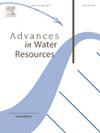基于隐马尔可夫和多项模型的非平稳水文干旱预测
IF 4.2
2区 环境科学与生态学
Q1 WATER RESOURCES
引用次数: 0
摘要
了解干旱变化的驱动因素对于制定有效的适应和管理战略至关重要。本研究开发了一种两步建模方法来表征和预测非平稳环境下的水文干旱。首先,利用多变量隐马尔可夫模型(HMM)将低水位时间序列划分为干年、正常年和湿年,将干年确定为水文干旱。其次,提出了一个多项逻辑回归模型(MLR)来预测低水位类转换,将外部变量纳入转换矩阵估计。还推导了年最小值的降水阈值,并通过自举重采样评估了不确定性和敏感性。我们的框架成功地应用于巴拉圭河流域(PRB),在那里水文变量的长期变化是频繁的。HMM过渡矩阵显示,每个水位等级的持续时间都很长,两个时期(1901-1960和1961-2024)之间存在不均匀性。第二阶段表现出更长的湿润、干燥和非干燥年份,表明驱动动力发生了变化。确定了持续13年(1961-1973)的多年度水文干旱,随后是46年(1974-2019),研究区域没有干旱。我们的模拟表明,46年无干旱期发生的概率只有4%。降水是状态转换的主要预测因子,但类别转换概率和降水阈值是非均匀的,且取决于当前的低水位状态。我们根据当前的水位确定了在干湿和正常年份之间开始转换的降水阈值:在正常年份,低于1040毫米的降水会引发水文干旱,而在干旱年份,高于1180毫米的降水会引发恢复正常条件。该研究通过提出一种估算水文干旱发生非均匀性的有效新方法,推进了非平稳极端事件分析;确定长期持续的水文干旱事件及其相关概率;确定降水阈值;揭示了低水位位移耦合驱动因素的重要性。本文章由计算机程序翻译,如有差异,请以英文原文为准。

Integrating Hidden Markov and Multinomial models for hydrological drought prediction under nonstationarity
Understanding the drivers of drought variability is crucial for developing effective adaptation and management strategies. This study develops a two-step modelling approach to characterize and predict hydrological droughts in a nonstationary context. First, a multivariate Hidden Markov Model (HMM) is used to classify low-water level time series into Dry, Normal, and Wet years, identifying Dry years as hydrological droughts. Second, a Multinomial Logistic Regression model (MLR) is proposed to predict low-water level class transitions, incorporating external variables into the transition matrix estimates. Precipitation thresholds for annual minima are also derived, with uncertainties and sensitivities assessed via bootstrap resampling. Our framework was successfully applied to the Paraguay River basin (PRB), where long-term changes in hydrological variables are frequent. The HMM transition matrix reveals a long persistence of years in each water level class and an inhomogeneity between two periods (1901–1960 and 1961–2024). The second period exhibits more extended runs of wet, dry, and non-dry years, suggesting a change in the driving dynamics. A multi-annual hydrological drought lasting for 13 years (1961–1973) was identified, followed by a stretch of 46 years (1974–2019) with no droughts in the study area. Our simulations indicate that the 46-year period with no drought had only a 4 % probability of occurrence. Precipitation is the primary predictor of regime shifts, but the class transition probabilities and precipitation thresholds are non-homogeneous and conditional on the current low-water level regime. We identify precipitation thresholds for initiating transitions between Dry, Wet and Normal years, conditioned on the current water levels: in a normal year, precipitation below 1040 mm triggers a hydrological drought, while in a drought year, precipitation above 1180 mm triggers a return to normal conditions. The research advances nonstationary extreme event analysis by proposing an efficient new approach to estimate inhomogeneity in hydrological drought occurrence; identify long persistence of hydrological drought episodes and their associated probabilities; define precipitation thresholds; and reveal the importance of coupled drivers of low water level shifts.
求助全文
通过发布文献求助,成功后即可免费获取论文全文。
去求助
来源期刊

Advances in Water Resources
环境科学-水资源
CiteScore
9.40
自引率
6.40%
发文量
171
审稿时长
36 days
期刊介绍:
Advances in Water Resources provides a forum for the presentation of fundamental scientific advances in the understanding of water resources systems. The scope of Advances in Water Resources includes any combination of theoretical, computational, and experimental approaches used to advance fundamental understanding of surface or subsurface water resources systems or the interaction of these systems with the atmosphere, geosphere, biosphere, and human societies. Manuscripts involving case studies that do not attempt to reach broader conclusions, research on engineering design, applied hydraulics, or water quality and treatment, as well as applications of existing knowledge that do not advance fundamental understanding of hydrological processes, are not appropriate for Advances in Water Resources.
Examples of appropriate topical areas that will be considered include the following:
• Surface and subsurface hydrology
• Hydrometeorology
• Environmental fluid dynamics
• Ecohydrology and ecohydrodynamics
• Multiphase transport phenomena in porous media
• Fluid flow and species transport and reaction processes
 求助内容:
求助内容: 应助结果提醒方式:
应助结果提醒方式:


